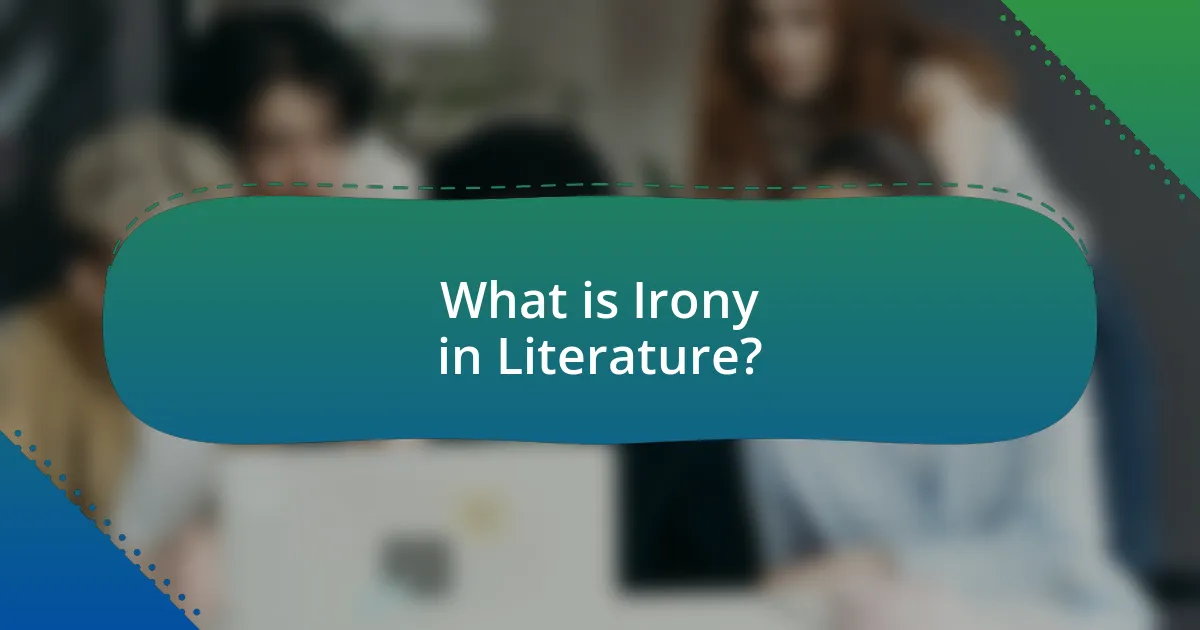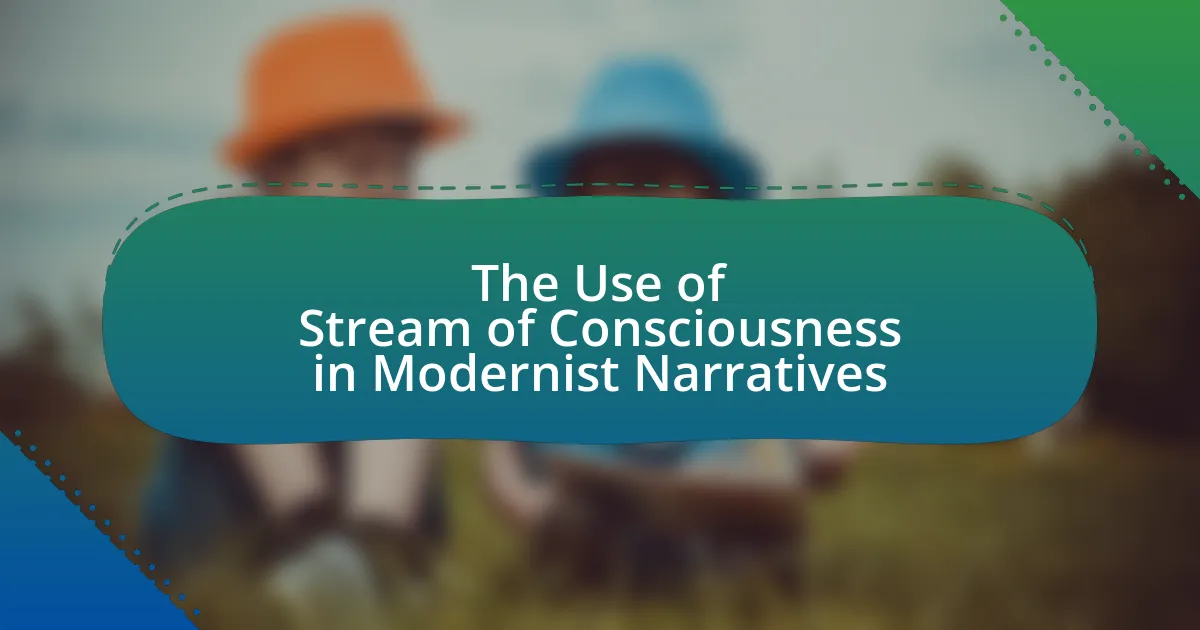The article focuses on analyzing the use of irony in the works of Jane Austen, highlighting its significance as a rhetorical device that contrasts intended meanings with literal interpretations. It explores various forms of irony, including verbal, situational, and dramatic irony, and discusses how these elements enhance narrative and character development. The article emphasizes Austen’s critique of societal norms through irony, particularly in her novels “Pride and Prejudice” and “Emma,” revealing themes related to social class, gender roles, and the complexities of human relationships. Additionally, it provides insights into techniques for analyzing irony, the emotional responses it evokes in readers, and best practices for studying Austen’s literature.

What is Irony in Literature?
Irony in literature is a rhetorical device where the intended meaning of words is different from their literal meaning, often creating a contrast between expectation and reality. This device can manifest in various forms, including verbal irony, where a speaker says one thing but means another; situational irony, where an outcome is contrary to what was expected; and dramatic irony, where the audience knows more about a situation than the characters do. For example, in Jane Austen’s works, irony often highlights social norms and character flaws, effectively critiquing societal expectations while engaging readers through humor and wit.
How is irony defined in the context of literary analysis?
Irony in the context of literary analysis is defined as a rhetorical device where the intended meaning of words is different from their literal meaning, often highlighting contradictions between appearance and reality. This device serves to create a deeper understanding of characters and themes, as seen in Jane Austen’s works, where irony often underscores social critiques and character flaws. For example, in “Pride and Prejudice,” Austen employs situational irony when characters’ true intentions are revealed, contrasting their outward behavior, thus enriching the narrative and engaging the reader in a critical examination of societal norms.
What are the different types of irony commonly found in literature?
The different types of irony commonly found in literature are verbal irony, situational irony, and dramatic irony. Verbal irony occurs when a speaker says one thing but means another, often for humorous or emphatic effect, as seen in works where characters express the opposite of their true feelings. Situational irony involves a discrepancy between what is expected to happen and what actually occurs, highlighting the unpredictability of life, which can be illustrated through plot twists in narratives. Dramatic irony arises when the audience knows more about a situation than the characters do, creating tension and engagement, as frequently utilized in classic literature to enhance emotional depth. These types of irony serve to enrich storytelling by adding layers of meaning and engaging readers on multiple levels.
How does irony function to enhance narrative and character development?
Irony enhances narrative and character development by creating contrasts between expectations and reality, which deepens the reader’s understanding of characters and their motivations. In Jane Austen’s works, irony often reveals the true nature of characters, as seen in “Pride and Prejudice,” where Elizabeth Bennet’s initial judgments of Mr. Darcy are challenged by later revelations, showcasing her growth and the complexity of social interactions. This use of situational irony not only propels the plot but also invites readers to engage critically with the characters’ flaws and societal norms, ultimately enriching the narrative.
Why is irony significant in the works of Jane Austen?
Irony is significant in the works of Jane Austen because it serves as a critical tool for social commentary and character development. Austen employs irony to highlight the discrepancies between appearance and reality, particularly in the context of social norms and relationships. For instance, in “Pride and Prejudice,” the ironic portrayal of Mr. Darcy’s initial aloofness contrasts with his eventual kindness, revealing deeper truths about social class and personal growth. This use of irony not only engages readers but also encourages them to question societal expectations and the authenticity of characters’ motivations.
What themes does irony help to convey in Austen’s novels?
Irony in Austen’s novels conveys themes of social class, gender roles, and the disparity between appearance and reality. For instance, in “Pride and Prejudice,” the ironic portrayal of Mr. Darcy’s initial aloofness contrasts with his eventual character development, highlighting the theme of misjudgment based on social status. Additionally, in “Emma,” the irony surrounding Emma Woodhouse’s matchmaking efforts underscores the limitations imposed by gender expectations and societal norms. These examples illustrate how Austen employs irony to critique social structures and reveal deeper truths about human behavior and relationships.
How does Austen’s use of irony reflect societal norms of her time?
Austen’s use of irony serves as a critical lens through which societal norms of her time are examined and often critiqued. By employing irony, she highlights the contradictions between societal expectations and individual desires, particularly regarding marriage, class, and gender roles. For instance, in “Pride and Prejudice,” the irony surrounding Mr. Collins’ proposal to Elizabeth Bennet underscores the absurdity of social conventions that prioritize financial security over genuine affection. This reflects the societal norm that marriage was often viewed as a transactional arrangement rather than a romantic union. Additionally, Austen’s ironic commentary on characters like Lady Catherine de Bourgh reveals the pretentiousness and hypocrisy of the upper class, showcasing how societal norms can lead to moral failings. Thus, Austen’s irony not only entertains but also invites readers to question and reflect on the values of her contemporary society.

How does Jane Austen employ irony in her novels?
Jane Austen employs irony in her novels primarily through the use of free indirect discourse, which allows her to present characters’ thoughts and feelings while subtly contrasting them with the narrator’s perspective. This technique creates a layer of irony, as readers often perceive the discrepancies between characters’ self-perceptions and the reality of their situations. For example, in “Pride and Prejudice,” Elizabeth Bennet’s initial judgments about Mr. Darcy are steeped in irony, as her misinterpretations highlight her own biases and lead to humorous situations. Austen’s ironic commentary often critiques social norms and the limitations placed on women, as seen in “Emma,” where the protagonist’s misguided matchmaking efforts reveal her own flaws and the absurdities of her social environment. This multifaceted use of irony not only enhances character development but also serves as a vehicle for social critique, making her novels rich in both humor and insight.
What are some notable examples of irony in Austen’s works?
Notable examples of irony in Jane Austen’s works include the character of Mr. Collins in “Pride and Prejudice,” whose pompous proposal to Elizabeth Bennet highlights the absurdity of social conventions regarding marriage. Additionally, in “Emma,” the protagonist’s misguided matchmaking efforts lead to unintended consequences, showcasing situational irony as her attempts to control others’ lives backfire. In “Sense and Sensibility,” the contrast between Elinor Dashwood’s reserved demeanor and her emotional struggles exemplifies dramatic irony, as readers are aware of her internal conflict while other characters remain oblivious. These instances illustrate Austen’s skillful use of irony to critique societal norms and character flaws.
How does situational irony manifest in “Pride and Prejudice”?
Situational irony in “Pride and Prejudice” primarily manifests through the unexpected outcomes of characters’ actions and societal expectations. For instance, Elizabeth Bennet initially rejects Mr. Darcy due to his pride, yet later discovers that his true character is vastly different from her assumptions, leading to her eventual acceptance of him. This reversal highlights the irony of her misjudgment based on first impressions, which is a central theme in the novel. Additionally, Mr. Collins proposes to Elizabeth, believing that she will be flattered by his offer, but she finds his proposal absurd and rejects him, showcasing the irony of his confidence in her acceptance despite her clear disinterest. These examples illustrate how Austen employs situational irony to critique social norms and character perceptions.
What role does verbal irony play in “Emma”?
Verbal irony in “Emma” serves to highlight the discrepancies between characters’ perceptions and reality, often revealing deeper truths about social dynamics and personal relationships. For instance, Emma Woodhouse frequently employs verbal irony in her interactions, which underscores her misguided confidence in her matchmaking abilities and her lack of self-awareness. This irony not only adds humor but also critiques the social norms of her time, as seen when she misinterprets the feelings of others, leading to misunderstandings that propel the narrative forward. Austen’s use of verbal irony thus enriches character development and enhances thematic exploration of social class and personal growth.
How does Austen’s irony contribute to character development?
Austen’s irony significantly contributes to character development by revealing the true nature and motivations of her characters. Through her use of situational and verbal irony, Austen exposes the discrepancies between characters’ perceptions and reality, allowing readers to gain deeper insights into their personalities. For instance, in “Pride and Prejudice,” Mr. Darcy’s initial pride is contrasted with his later actions, showcasing his growth and complexity. This irony not only enhances the narrative but also encourages readers to question societal norms and character judgments, ultimately leading to a more nuanced understanding of each character’s journey.
In what ways does irony reveal the true nature of characters?
Irony reveals the true nature of characters by highlighting contradictions between their words and actions, exposing their flaws and motivations. In Jane Austen’s works, characters often present themselves in a socially acceptable manner, yet their ironic statements or situations reveal deeper truths about their personalities. For example, in “Pride and Prejudice,” Mr. Darcy’s initial pride contrasts with his eventual humility, which is unveiled through ironic situations that challenge his self-perception. This use of irony not only serves to develop character depth but also critiques societal norms, as seen in the way characters navigate their social environments while concealing their true intentions.
How does irony affect the reader’s perception of protagonists and antagonists?
Irony significantly shapes the reader’s perception of protagonists and antagonists by creating a contrast between their intentions and the outcomes of their actions. In Jane Austen’s works, irony often highlights the flaws and contradictions in characters, allowing readers to see protagonists as more relatable and complex, while simultaneously exposing the shortcomings of antagonists. For example, in “Pride and Prejudice,” Elizabeth Bennet’s initial misjudgment of Mr. Darcy is steeped in irony, as her perceptions shift throughout the narrative, ultimately revealing her growth and depth as a protagonist. Conversely, characters like Mr. Wickham are portrayed through ironic situations that unveil their deceitful nature, reinforcing their role as antagonists. This use of irony not only enhances character development but also engages readers in a deeper understanding of moral and social themes within the narrative.
What are the effects of irony on readers’ interpretations of Austen’s works?
Irony significantly shapes readers’ interpretations of Austen’s works by creating a layer of complexity that encourages critical engagement. This literary device often highlights the disparity between characters’ perceptions and reality, prompting readers to question societal norms and character motivations. For instance, in “Pride and Prejudice,” the ironic portrayal of Mr. Darcy’s initial aloofness contrasts with his eventual benevolence, leading readers to reassess their judgments about social class and personal growth. Such irony not only enhances the narrative depth but also fosters a more nuanced understanding of themes like marriage, morality, and social status, as evidenced by scholarly analyses that emphasize how Austen’s ironic tone invites readers to reflect on their own biases and assumptions.
How does irony influence the emotional responses of readers?
Irony significantly influences the emotional responses of readers by creating a contrast between expectations and reality, which often evokes feelings of amusement, empathy, or discomfort. In Jane Austen’s works, for instance, her use of situational and verbal irony allows readers to engage with characters’ flaws and societal norms critically, leading to a deeper emotional investment in the narrative. This engagement is supported by the fact that irony often highlights the absurdities of social conventions, prompting readers to reflect on their own values and experiences, thereby enhancing their emotional connection to the story.
What insights can readers gain from recognizing irony in Austen’s narratives?
Recognizing irony in Austen’s narratives allows readers to gain insights into the complexities of social norms and character motivations. Austen employs irony to critique societal expectations, revealing the discrepancies between appearance and reality, particularly in the context of marriage and class. For instance, in “Pride and Prejudice,” the ironic portrayal of Mr. Collins highlights the absurdity of social status and the institution of marriage, prompting readers to question the values of Regency society. This use of irony not only enhances character development but also encourages critical reflection on the moral and ethical dilemmas faced by individuals within their social contexts.
How does irony challenge readers’ expectations in Austen’s storytelling?
Irony in Austen’s storytelling challenges readers’ expectations by subverting conventional norms and character motivations. For instance, in “Pride and Prejudice,” the initial portrayal of Mr. Darcy as proud and aloof contrasts sharply with his eventual revelation as a deeply caring individual, prompting readers to reassess their judgments. This use of situational irony not only creates tension but also encourages deeper engagement with the characters and themes, as readers must navigate the disparity between appearance and reality. Austen’s ironic commentary on social class and marriage further complicates expectations, as seen in “Emma,” where the protagonist’s misguided matchmaking leads to unexpected outcomes, highlighting the unpredictability of human relationships.
What techniques can readers use to analyze irony in Austen’s works?
Readers can analyze irony in Austen’s works by examining character dialogue, narrative voice, and situational contrasts. Character dialogue often reveals discrepancies between what characters say and what they truly mean, highlighting verbal irony. The narrative voice, characterized by a distinct tone and perspective, can provide insights into the author’s ironic commentary on societal norms and character behaviors. Additionally, situational contrasts, where outcomes differ from expectations, underscore dramatic irony, allowing readers to appreciate the complexities of the plot and character motivations. These techniques enable a deeper understanding of Austen’s critique of social conventions and human behavior.
How can close reading enhance the understanding of irony in her novels?
Close reading enhances the understanding of irony in Jane Austen’s novels by allowing readers to meticulously analyze language, structure, and character interactions. This detailed examination reveals the nuanced layers of meaning and the contrasts between appearance and reality that are central to Austen’s ironic style. For instance, in “Pride and Prejudice,” close reading of dialogue and narrative voice uncovers the irony in Elizabeth Bennet’s judgments and Mr. Darcy’s character development, illustrating how their perceptions shift over time. Such analysis highlights the social commentary embedded in the text, demonstrating how irony serves to critique societal norms and expectations.
What are some common pitfalls to avoid when interpreting irony in literature?
Common pitfalls to avoid when interpreting irony in literature include misunderstanding the author’s intent, failing to recognize the context, and confusing irony with sarcasm. Misinterpreting the author’s intent can lead to incorrect conclusions about the themes and messages in the work. For example, in Jane Austen’s novels, irony often serves to critique societal norms, and overlooking this can result in a superficial reading. Additionally, failing to recognize the context in which the irony is presented can obscure its meaning; irony is often tied to specific cultural or historical circumstances that inform its interpretation. Lastly, confusing irony with sarcasm can lead to misinterpretation, as sarcasm typically conveys contempt, while irony may express a more nuanced critique or observation. Understanding these pitfalls is essential for a deeper appreciation of literary irony.
What are the best practices for studying irony in Jane Austen’s literature?
The best practices for studying irony in Jane Austen’s literature include close textual analysis, understanding historical context, and exploring character motivations. Close textual analysis allows readers to identify instances of verbal, situational, and dramatic irony, which are prevalent in Austen’s works. Understanding the historical context of the Regency era enhances comprehension of social norms and expectations that Austen critiques through irony. Additionally, exploring character motivations reveals how irony serves to develop themes such as class, gender, and morality, as seen in novels like “Pride and Prejudice” and “Emma.” These practices collectively provide a comprehensive framework for analyzing the nuanced use of irony in Austen’s literature.




